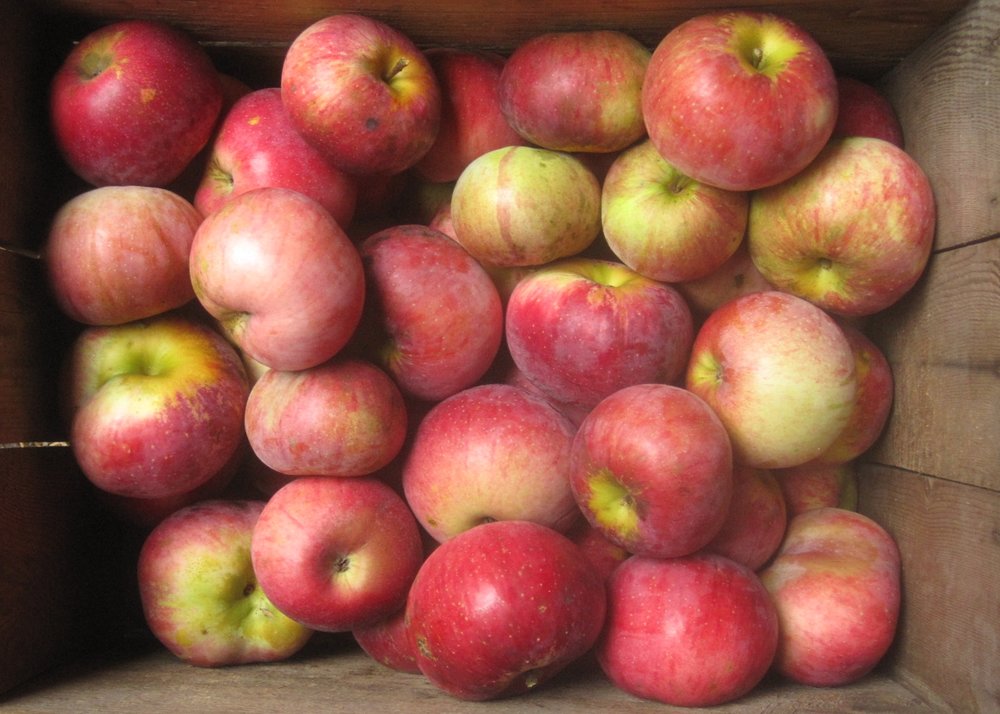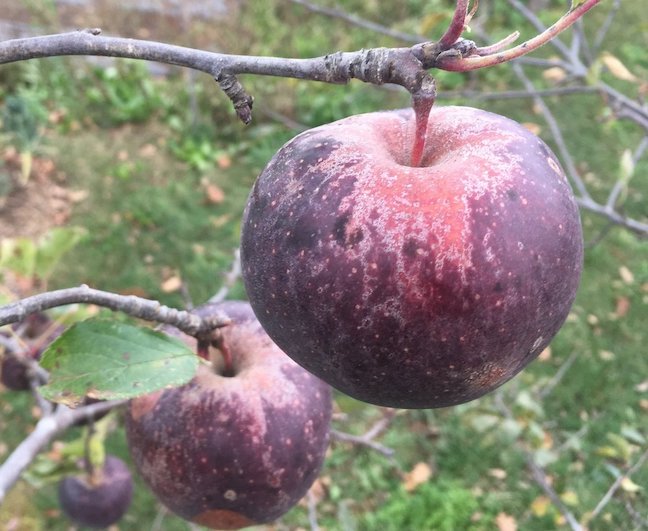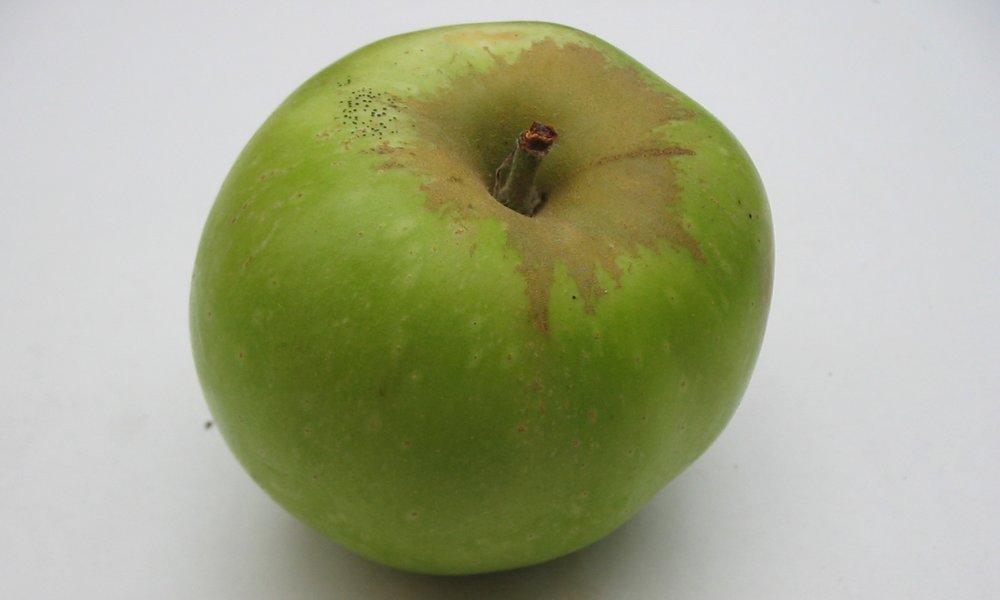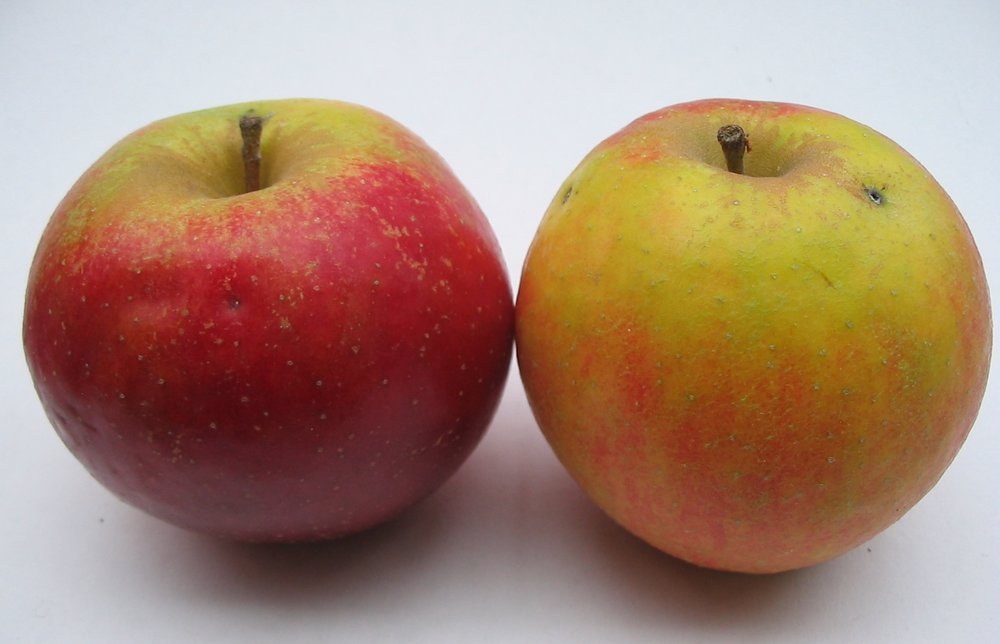By Jacob Mentlik
For decades Maine’s apple expert and pomological detective John Bunker has been hunting for and rediscovering rare old varieties of apples. Using all of the clues he can gather, he pieces together the history and possible locations of ancient trees, finds and collects fruit and then spends hours poring over old books and watercolors of heirloom apples to see if the descriptions match the specimens that he has gathered. In this way Bunker has found and identified many old Maine apples once thought to be lost.
MOFGA’s Maine Heritage Orchard (MHO) is home to many of the findings of Bunker and other Maine fruit explorers. The MHO collection also includes hundreds of heirloom apple varieties historically grown in Maine that have been sourced from other verified heirloom orchards across the country. Additionally, there are many varieties propagated from ancient trees found on old Maine farm sites, along roadsides and even buried in the woods, whose identities have yet to be confirmed. Some of these trees are presumed to be unique seedlings – the only ones of their type in existence – while others are thought to be heirloom varieties that we know were grown here in Maine, but we have yet to prove their identity with 100% certainty. All of these unknown varieties are provisionally named and details about their possible identities have been recorded.
When trying to locate and identify a specific lost apple variety, the shape and color may be a fit and the location might match historical records of a town where the apple was grown, yet it is sometimes impossible to be certain that you have found the true Fameuse or Blenheim Orange apple. Oftentimes two apples from different trees in opposite parts of the state may curiously seem identical, such as the Golden Ball apples found in coastal Harpswell and all the way in the western town of Weld. Furthermore, with some ancient trees it is difficult to determine whether the tree was grafted to a known variety or simply grew up from an errant seed. Up to this point, many of the apple identifications made have been highly educated guesses.

The popular Redfield apple gets its large size from the genetics of Wolf River, shown here.
Now, with the help of Cameron Peace, a geneticist from Washington State University’s department of horticulture, we can confirm some of these findings and begin to unravel the mysteries. WSU is a leader in fruit tree breeding working to develop new cultivars. Traditionally, when apples are bred it involves an intentional cross between two types of apples with desirable traits. For instance, the increasingly popular Redfield apple combines the deep red flesh of the Russian apple Niedzwetzkyana with the large size and palatability of Wolf River. At WSU, scientists are also using SNP (single nucleotide polymorphism) array testing, a type of state-of-the-art DNA testing, to inform their choices and to select parents for new apple crosses. WSU researchers are mapping their DNA findings of the Malusgenus as part of the multi-institutional tree fruit Genome Database Resources project.
This ability to test the DNA of specific apple varieties has proven to be immensely helpful to apple sleuths and fruit explorers. By sending a small leaf sample to the WSU lab, we can now receive informative details about the parentage of apple varieties and their potential relationships to other apples in the database. Slowly, pedigrees of rare varieties whose histories are largely unknown are being revealed.

Thanks to genetic testing, we now know that Black Oxford was a chance cross between Blue Pearmain and Hunt Russet, two old Massachusetts varieties.
In partnership with Fedco Trees, MHO has been submitting samples of many apples in question, and we have received some very interesting and exciting results. For instance, we now know that Maine’s beloved Black Oxford apple, a dark purple winter-keeper found in Paris, Maine, around 1790, was a chance cross between Blue Pearmain and Hunt Russet, two extremely old Massachusetts varieties that came north with settlers of Oxford County well over 200 years ago. It is now clear that Black Oxford received genes for its storage ability from Hunt Russet, while it inherited its stunning purple skin from Blue Pearmain.

Many greenings planted in the Maine Heritage Orchard were determined to be the Rhode Island Greening through the use of genetic testing.
Two other popular Maine apples, Cherryfield and Benton Red, long suspected to be the same by MOFGA orchardist Laura Sieger, were confirmed to be identical, and also a match to the Illinois apple known as Salome. We have also learned that many of the “greenings” we have found over the years are identical to Rhode Island Greening, a popular cooking apple from the 17th century, and many of the russets in the MHO collection are a match with the classic Golden Russet.
Another apple grown at the Maine Heritage Orchard, grafted from a mother tree in Harpswell that was thought to be the lost variety Givens, has actually been found to be identical to the old Massachusetts apple Hubbardston Nonesuch. So the search for the true Givens resumes. Let us know if you find an apple that resembles Hubbardston – large and orange-red with some ribbing – grown near Sagadahoc County, it just might be the long-lost Givens.
Finally, many genetic samples have been found to be “unique unknowns,” meaning that they are either one-of-a-kind seedling apples or varieties not yet in the WSU database. Occasionally a parent, grandparent or sibling shows up in the pedigree of these mysterious apples, but still no identity is revealed. All of these unique unknowns are of particular interest to us at MHO because they may turn out to be ancient Maine varieties thought to have been lost generations ago.
These recent DNA results have helped us to make room for more varieties in the Maine Heritage Orchard. Instead of starting new trees in the nursery for future MHO plantings, this spring we grafted scions of 26 “new” varieties onto existing trees that we now know are duplicates. This frees up space for several more years of plantings at MHO, including a new block of pears established this year.

Does this apple look familiar? It’s the Hubbardston Nonesuch, a lookalike to the elusive Givens. If you find such a specimen growing near Sagadahoc County, contact the Maine Heritage Orchard.
The search for lost Maine varieties on MHO’s wish list continues. Using historical references found in 19th century agricultural reports, articles in old newspapers, diaries, letters, faded photos, paintings and other contextual clues, we are now working in collaboration with the latest in genetic findings to track down dozens of old Maine varieties before they slip into extinction.
Jacob Mentlik is a nurseryman, orchardist and homesteader living at After the Fall Farm in Montville, Maine. He is also the scionwood coordinator for Fedco Trees and helps research and care for the trees at the Maine Heritage Orchard.
